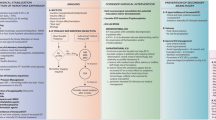Abstract
Physicians face a therapeutic dilemma in patients with acute hemorrhagic stroke requiring long-term, high-intensity anticoagulants because this treatment increases the risk of intracranial hemorrhage (ICH) 8- to 11-fold. We retrospectively studied 15 patients with ICH which occurred under anticoagulation with phenprocoumon, with an international normalized ratio (INR) of 2.5–6.5 on admission. Hemispheric, thalamic, cerebellar, intraventricular, or subarachnoid hemorrhage without aneurysm occurred. Absolute indications for anticoagulation were double, mitral, or aortic valve replacement, combined mitral valve failure with atrial fibrillation and atrial enlargement, internal carotid artery-jugular vein graft, frequently recurring deep vein thrombosis with risk of pulmonary embolism, and severe nontreatable ischemic heart disease. As soon as the diagnosis of ICH was established, INR normalization was attempted in all patients by administration of prothrombin complex, fresh frozen plasma, or vitamin K. After giving phenprocoumon antagonists (and neurosurgical therapy in four patients) heparin administration was started. Nine patients received full-dose intravenous and six low-dose subcutaneous heparin. The following observations were made: (a) All patients with effective, full-dose heparin treatment with a 1.5- to 2-fold elevation in partial thromboplastin time after normalization of the INR were discharged without complication. (b) Three of four of the patients with only incomplete correction of the INR (> 1.35) experienced relevant rebleeding within 3 days (all patients with an INR higher than 1.5), two of whom were on full-dose heparin. (c) Three of seven of the patients with normalized INR and without significant PTT elevation developed severe cerebral embolism. Although our data are based on a retrospective analysis, they support treatment with intravenous heparin (partial thromboplastin time 1.5–2 times baseline value) after normalization of the INR in patients with an ICH and an urgent need for anticoagulation.
Similar content being viewed by others
Author information
Authors and Affiliations
Additional information
Received: 1 September 1999/Received in revised form: 28 October 1999/Accepted: 19 November 1999
Rights and permissions
About this article
Cite this article
Bertram, M., Bonsanto, M., Hacke, W. et al. Managing the therapeutic dilemma: patients with spontaneous intracerebral hemorrhage and urgent need for anticoagulation. J Neurol 247, 209–214 (2000). https://doi.org/10.1007/s004150050565
Issue Date:
DOI: https://doi.org/10.1007/s004150050565




